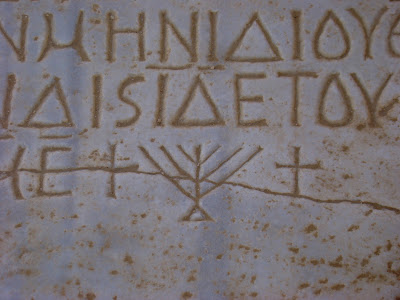"I, Estelle Brettman, being of sound mind, hereby declare that I should like to see such goals of the International Catacomb Society perpetuated with projects appropriate to the purpose for which the Society was established." (Testament of Estelle Shohet Brettman, 1991)
"It seems to me that your project deserves all support it can possibly get, and I am particularly delighted with your emphasis on 'the shared heritage of the Early Christian and Jewish communities of Rome'." (Prof. Herbert Bloch, Pope Professor of the Latin Language and Literature, Department of the Classics, Harvard University, in letter to ESB of 25 January 1983)
"You have shown the Vatican that there is Jewish interest in the Jewish catacombs." (Dr. Yale J. Berry, MD, letter to ESB of 25 September 1986)

International Catacomb Society Founder, Estelle Shohet Brettman, at the opening of "Vaults of Memory" in Boston in 1987.
The International Catacomb Society (ICS) is an established resource for the study of the Ancient Mediterranean. The ICS was founded in 1980 by Estelle Shohet Brettman to raise awareness of the need for the preservation and documentation of the Roman Jewish catacombs and related sites that illustrate the common influences on Jewish, Christian, and pagan iconography and funerary practices during the time of the Roman Empire.
Although most people are aware that the catacombs are underground burial galleries, the existence of extensive wall paintings and inscriptions from the catacombs are not as well known. The paintings from the catacombs are some of the finest existing examples of wall painting from their time period (primarily from the early third through fourth century C.E.). The iconography of the paintings along with the inscriptions from the catacombs provide extensive information to document the history of the groups of people who were buried in them, including pagans, Jews, and early Christians.
The founder of the ICS, Estelle Shohet Brettman, began her career as a marine biologist, but by the late 1960s and early ’70s, an interest in antiquity led her to become an expert on the iconography of ancient gems and seals, and a docent and lecturer on the subject at the Museum of Fine Arts, Boston. Her frequent trips to Italy led to the subject that became the passion of her later life. Her art lover’s eye and researcher’s intellect were stimulated by the decoration of ancient structures, especially the catacombs, and the inscriptions she sometimes literally stumbled over at ancient sites. She set out to learn all she could about the life and beliefs of the people who had created or were commemorated by the ancient remains. She was impressed that for a time under the Roman Empire, Classical paganism, Judaism, and early Christianity existed side-by-side, mingling influences, until the differences between them became the ruling issues and common roots were forgotten. To Estelle, the common roots that she saw so vividly illustrated in the catacombs were the keys to ecumenical understanding.
Link to "Our Founder" (Estelle Shohet Brettman)
One of the projects that Estelle undertook, which has left a valuable resource for scholars, was to create a photographic archive of the imagery in the catacombs. During the 1970s and 1980s, with the assistance of the Vatican, the Italian antiquities service, and innumerable individuals who became supportive friends, she took thousands of photographs of the paintings in the catacombs. She was not deterred by the sometimes humid, dusty, and claustrophobic conditions, and even took many photographs by the light of a gas lantern. This extensive photographic archive served as the basis for much of her research on the catacombs and led her to create the photographic exhibit Vaults of Memory as a visual essay of shared symbols of Jewish, Christian, and pagan funerary art in the Roman catacombs. The exhibition has met with enthusiastic responses at the Boston Public Library, the Castel Sant' Angelo in Rome, the National Academy of Sciences in Washington, D.C., the Kelsey Museum of Archaeology at the University of Michigan, and the Bible Lands Museum in Jerusalem, among other venues. The complete Vaults of Memory exhibition can now be viewed online.
Links to "Vaults of Memory" exhibit
In the years since Estelle Brettman’s death in 1991, the ICS has continued her work to preserve and document the catacombs. The extensive photographic archive that Estelle created has been fully digitized and cataloged and is available online. The ICS continues to add new images to its DAPICS database, including an extensive set of images from Early Christian sites in Tunisia, which is available to ICS members.
Link to the Digitized Archives Project of the International Catacomb Society (DAPICS)
In 2001 the ICS sponsored structural stabilization work in the Jewish Randanini catacomb and during the same year founded the Shohet Scholars Program to honor Estelle Shohet Brettman. Through the scholars program, the ICS offers a grant of up to $30,000 each year to support the work of scholars in the fields of archeology, art history, classical studies, history, comparative religions, or related subjects. Of special interest are interdisciplinary projects that approach traditional topics from new perspectives.
Link to Shohet Scholars Grant Program
In 2005 the ICS permanently endowed the Estelle Shohet Brettman Memorial Lecture Series at the Museum of Fine Arts, Boston, in the Department of Ancient Art. The series presents lectures and other programs dealing with the cultural, artistic, and religious history and related archaeology of the ancient Mediterranean world, primarily the Roman Empire and its provinces during the period of the fifth century B.C.E. through the seventh century C.E.
